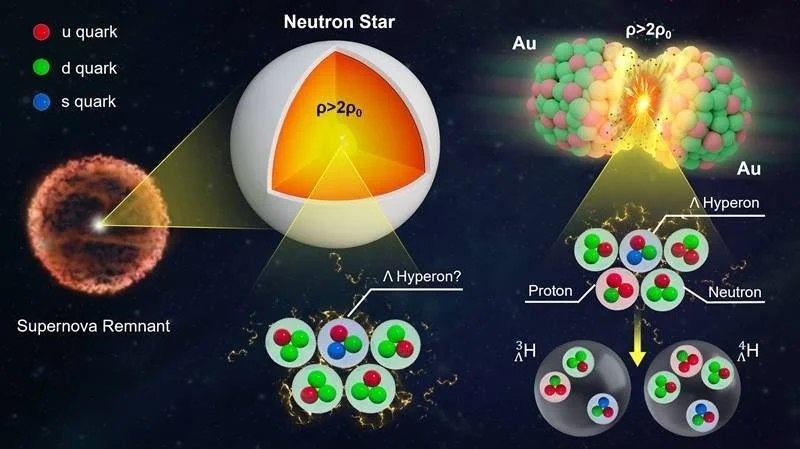New insights into how strange matter interacts with ordinary matter
First measurements of how hypernuclei flow from particle collisions may give insight into the strange matter makeup and properties of neutron stars.
By Department of Energy / Office of Science
Scientists reported the first observations of how nuclei containing strange quarks flow from particle collisions that smash atomic nuclei together at high energies. They specifically tracked the flow patterns of so-called hypernuclei. These hypernuclei contain particles called hyperons (made of at least one strange quark) in addition to ordinary protons and neutrons (known as nucleons).
Tracking nuclei containing strange-matter particles called hyperons (Λ) could help scientists learn about hyperon interactions with ordinary matter and understand the inner structure of neutron stars, where such strange matter may be abundant. Image courtesy of Brookhaven National Laboratory
The scientists observed that hypernuclei flow much the same as ordinary nuclei in a way that scales with their overall nuclear mass. This implies that hyperons interact with ordinary protons and neutrons the same way these ordinary nucleons interact with one another when they come together, or coalesce, to form nuclei.
The internal structure of neutron stars.
This research offers fresh insights into interactions between hyperons and nucleons. These are governed by the same nuclear strong force as the interactions among ordinary nucleons. However, scientists weren’t sure these interactions operated in the same way.
The new data showing similar flow patterns for hypernuclei and normal-matter nuclei imply that they do. This research into the behavior of strange matter hyperons may help scientists learn about the internal structure of neutron stars. Scientists believe these stars contain an abundance of hyperons and other strange matter—matter that contains strange quarks. The data will provide input for refining theorists’ calculations that describe the hyperon-nucleon interactions that drive the formation of hypernuclei.
This illustration shows the hot, dense, expanding cloud of debris stripped from the neutron stars just before they collided. This cloud produces the kilonova's visible and infrared light. Within this neutron-rich debris, large quantities of some of the universe's heaviest elements were forged, including hundreds of Earth masses of gold and platinum. Credit: NASA's Goddard Space Flight Center/CI Lab
Scientists with the STAR Collaboration used the STAR detector at the Relativistic Heavy Ion Collider (RHIC) to study the flow patterns of the debris emitted from collisions of gold nuclei. RHIC is a Department of Energy (DOE) Office of Science user facility. Comparing the flow patterns of hypernuclei—nuclei containing strange-matter hyperons—with the flow of similar ordinary nuclei gave the researchers fresh insight into the interactions of hyperons with protons and neutrons.
Previous experiments have shown that the flow patterns of regular nuclei generally scale with mass. This means that the more protons and neutrons a nucleus has, the more the nuclei exhibit collective flow in a particular direction. This indicates that these nuclei inherit their flow from their constituent protons and neutrons, which coalesce, or come together to form nuclei, because of their strong force interactions.
The STAR detector at Brookhaven's Relativistic Heavy Ion Collider (RHIC). As big as a house, STAR searches for signatures of the form of matter that RHIC aims to create: the quark-gluon plasma. Credit: Brookhaven National Laboratory
The STAR results show that hypernuclei follow this same mass-scaling pattern, implying that they most likely form via the same coalescence mechanism. The flow patterns also convey information about the matter generated in the particle smashups—including how hot and dense it is and other properties. The scientists will use additional measurements of how hypernuclei interact with that medium to learn more about its properties.
Provided by The Department of Energy
Reference: Aboona, B.E., et al. (STAR Collaboration). Observation of Directed Flow of Hypernuclei 3ΛH and 4ΛH in √sNN=3 GeV Au+Au Collisions at RHIC. Physical Review Letters (2023). DOI: https://doi.org/10.1103/physrevlett.130.212301




